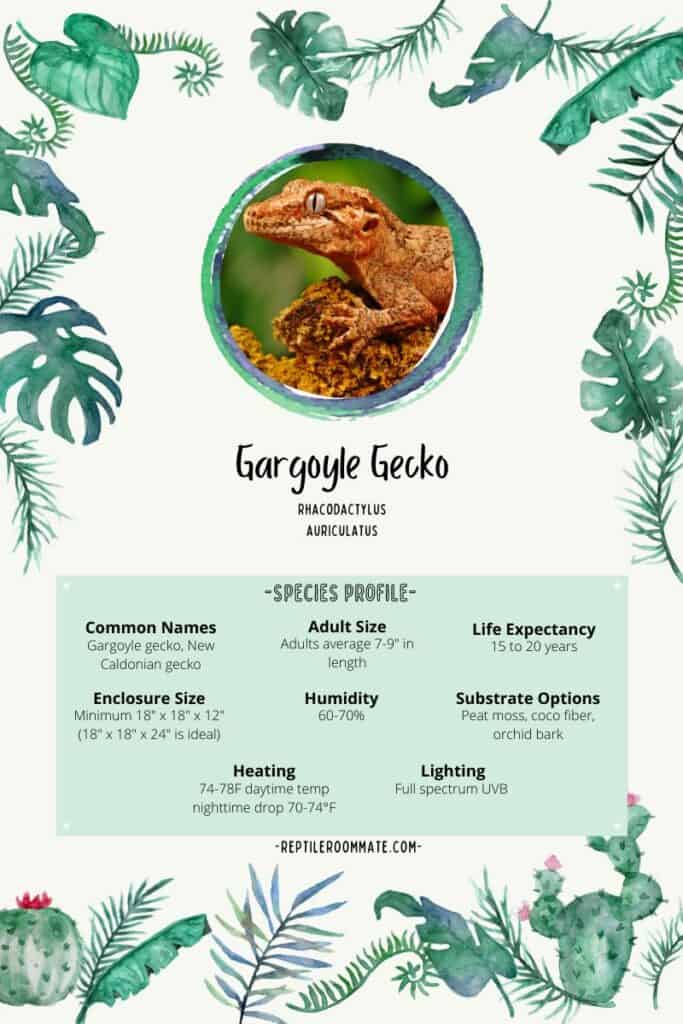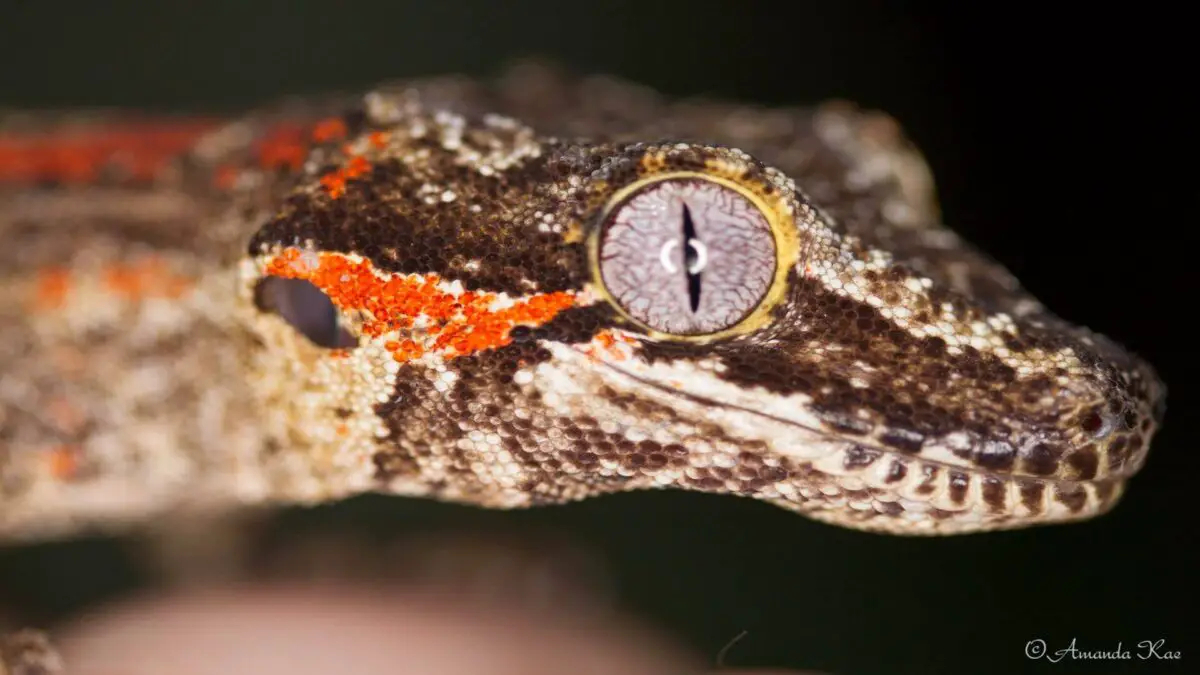Comprehensive Gargoyle Gecko Care Guide
For me gargoyle geckos are a lot like African fat tailed geckos in that they are the less popular versions (but just as good) of two of the most popular reptile pets; the leopard gecko and the crested gecko.
Gargoyles are quite similar to crested geckos in care requirements, husbandry, and even looks but they are just different enough to make them (in my opinion) even more sought after than their crested counterparts!
Reptile Roommate is a participant in the Amazon Services LLC Associates Program. As an Amazon Associate I earn from qualifying purchases.

Gargoyle Gecko Care Checklist
- Suitable enclosure (tank, terrarium, etc)
- Plants, branches, and vines for climbing
- Substrate (retains moisture)
- Heating
- Lighting (UVB not necessary) consider stronger lighting w/live plants
- Thermometer and hydrometer (calculate temperature and humidity)
Gargoyle Geckos In the Wild
Gargoyle geckos come from the Southern part of New Caledonia; a group of islands off the Eastern coast of Australia.
Gargoyles are arboreal geckos spending much of their time in the trees among the branches and leaves.
In the wild gargoyle geckos are threatened due to deforestation. In captivity however, gargs make excellent pet reptiles!
Size and Coloration
Ranging from 7-9″ inches; 3″ or so of that being tail-length. Adult gargoyles weigh approximately 60 to 70 grams and are considered to be medium-sized geckos.
Gargs come in an array of colors and patterns! They come in shades of brown, yellow, gold, white, yellow, and even red!
Patterns range from mottled to striped and banded. Individual geckos show varying degrees of coloration and patterning. Many even have beautiful contrasting rings around their eyes as can be seen in the photo below.
Are Gargoyle Geckos Difficult Pets?
Much like their popular “cousins” the leopard geckos, gargoyle geckos make great pets!
…not only for the advanced or experienced reptile keepers but for beginners as well!
The only caveat or potential (small) downside is that they may be a bit harder to find and they usually command a higher price than the average leopard gecko.
Do Gargoyle Geckos Bite?
As adults gargs are quite well tempered and are not prone to being very aggressive or quick to bite.
However as juveniles and young adults gargs can nip or bite on occasion.
A bite from a gargoyle gecko (rare as an adult) is really not that bad. They do have small sharp teeth though that, together with a small pinch/nip; quite possibly will draw a little blood.
On the chance that you do receive a nip from a gargoyle, just clean the area with soap and water and apply a small bandage if necessary.
Handling
Gargoyle geckos take well to handling. They can and do however have the ability to jump; and what great little jumpers they are!!
Like many geckos they do need to be handled with care. Never pick up or hold your garg by the tail!
Gargoyles can drop their tails when threatened or frightened. This is called caudal autotomy. Once a garg drops its tail, it will take while for the gargoyle to regrow it.
While a gargoyle may not drop its tail unless threatened or restrained in some way, sometimes gargs drop them for what seems like no good reason.
Also, other gargoyle geckos can and will bite or pick at each others’ tails, sometimes causing them to be dropped.
This is something that gargoyle gecko owners have come to accept and even appreciate. It’s all just part of having a gargoyle gecko as a pet!
Creating Your Gargoyle’s Enclosure
Being semi-arboreal lizards gargoyle geckos do great in enclosures that are tall or have good height so that they can climb and jump.
A 10 gallon tank (preferably on its side) or even a 20 gallon-tall aquarium is a good start. The height of the enclosure is more important than the length.
There is One Golden Rule for housing gargoyle geckos; DO NOT house males together. They will fight, they will hurt each other and BOTH will suffer, possibly even die.
Females are even known to pick on each other and hosing them together is not recommended.
You can house single male / female pairs together but only when the female is of breeding age and a healthy weight.
Gargoyle geckos will appreciate an enclosure that provides many branches, leaves, and vines to climb on.
Live plants such as pothos, philodendron, ficus, etc can provide excellent hiding spots and opportunity to drink water droplets from their leaves.
You also want to be sure that your enclosure has a secure screen lid or top (mostly to keep other things out rather than your crested gecko in) that provides adequate ventilation and support for a light if needed.
Humidity
Your gargoyle geckos will require a constant humidity of 60%-70%.
Maintaining such a humidity will require you to mist the geckos enclosure, sometimes multiple times a day.
Misting can be down with a simple spray bottle or with an automated system like MistKing.
Using a hydrometer, a device for measuring humidity is a must with gargs. Fortunately they are inexpensive and readily available.
Substrate
As a very basic substrate paper towels can be used to maintain a high level of sanitary conditions and aide in cleaning.
Many gargoyle owners however, use varying substrate mixes containing peat moss, coco fiber, or orchid bark. Substrates like these look great and also help to maintain humidity by retaining some moisture.
Temperature
A daily daytime temperature between 74-78°F is perfect for gargoyle geckos. A night time drop in temperature to 70-74°F is ideal.
Average household temperatures coincides with this night time temperature (65-75°F) so you most likely only need heating for your enclosure’s daytime temperatures.
Heating
Heating of your gargoyle gecko’s enclosure can be accomplished by using a ceramic heat emitter or low-watt red heat bulb.
Remember that crested geckos don’t like high temperatures (higher than most average household temperatures anyway) so heating elements or lamps don’t need to be extremely powerful.
Do not use heating rocks or stones that go inside of your enclosure. These can cause severe burns for your gecko.
Lighting
While your gargoyle gecko doesn’t require any specialized lighting, a low output UVB light can be beneficial as well as visually appealing to the colors and patterns of your gecko.
That said, lighting is more for any live plants in your enclosure and your own enjoyment rather than your geckos.
A simple fluorescent light shining above or on the screen cage top for 8-12 hours a day is perfect!
Food and Water
Water should be available at all times. A shallow, stable water dish should be provided. It should not be too deep that your gecko cannot easily crawl out of it.
Gargoyle geckos will drink from standing water but they will also hydrate themselves by licking water droplets from leaves when you mist they enclosure.
Gargs are omnivores; they eat a combination of plant and animal-based foods. Most gargoyle gecko keepers give their geckos a commercially available diet along with the occasional insect feeding. (If your gargoyle accepts them. Some may not)
Meal Replacement Powders
Commercially available meal replacements such as Pangea Fruit Mix Complete and Repashy Superfoods MRP are powders that you add water to and mix to a paste-like consistency which you then feed to your geckos.
Some gargoyle gecko owners forgo the prepared meal replacements and feed their geckos insects along with fresh fruit. Fruits such as banana, papaya, mango, strawberries, and watermelon are some examples. Smash or pulverize them to a consistency that can be easily eaten by the geckos.
Feeder Insects
You can supplement your gargoyle gecko’s diet with crickets, small feeder roaches, and wax worms. However, don’t be alarmed if your gargoyle refuse live feeder insects; some just don’t seem to enjoy them.
All insects should be “gut-loaded” prior to being fed to your gargoyle gecko. Gut-loading is accomplished by feeding the insects nutritious food for at least 24 hours before they are fed to your gecko. Things like fresh vegetables, fruits, tropical fish flakes, and commercial reptile food are insect feed.
Before feeding your gecko, feeder insects should also be “dusted” with specially formulated calcium, vitamin, and mineral powders. This is as simple as sprinkling a bit of powder on the insects to be fed before feeding them to your gecko. Just make sure that you don’t have an excess of powder getting all over your gecko’s enclosure or in the gecko’s eyes.
Adult gargoyle geckos should be fed three times a week with juveniles being fed daily.
Shedding
As gargoyle geckos grow they need to shed their old skin to make room for the new growth.
Fortunately shedding is something that gargs usually handle with ease. Gargoyle geckos will eat their shed skin.
The main thing you must do as a pet owner is provide them that sweet-spot of 60-70% humidity and they will take care of the rest.
However, if you gecko does show signs of a stuck shed (many times on the toes) have them soak in slightly warm water for a while and help them by rubbing the stuck shed gently with a Q-tip.
Notice that I bolded the word “rubbing.” The last thing you want to do is force or pull at stuck skin. Give it some time in the warm water and be patient.
Cover photo – “gremlin2” by Amanda Kae’s Photoz is licensed under CC BY 2.0

